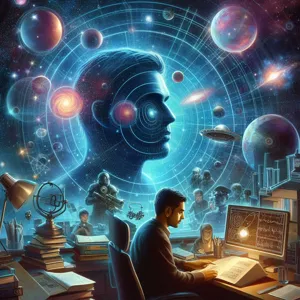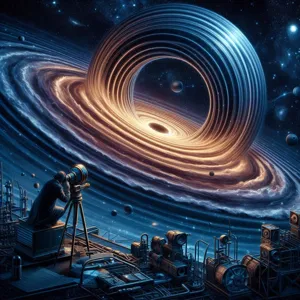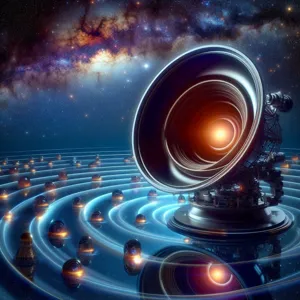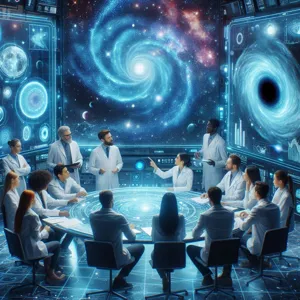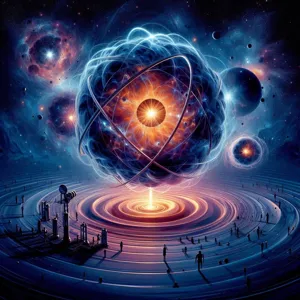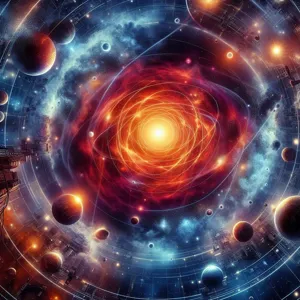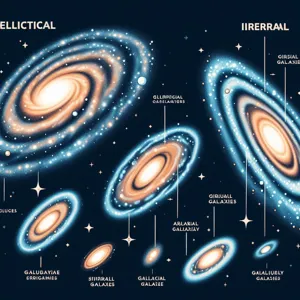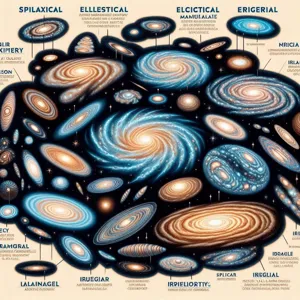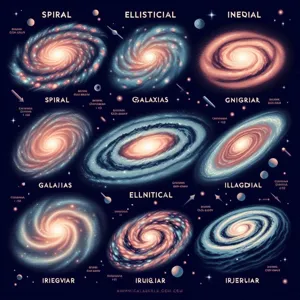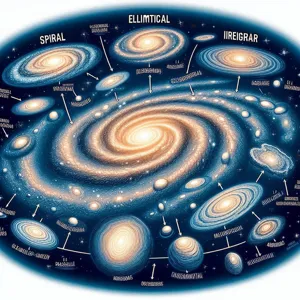The vastness of the universe has captivated humankind for centuries, igniting our imagination and fueling our quest for knowledge.
As we gaze up at the twinkling stars and the shimmering expanse of the night sky, we find ourselves pondering profound questions about our existence and the nature of reality. This intrigue leads us to two intertwined fields: astronomy, the scientific study of celestial objects and phenomena, and cosmology, the exploration of the universe’s origins, evolution, and ultimate fate. In this blog post, we will embark on a fascinating journey to unravel the intricate connection between these two disciplines. From the ancient stargazers who mapped the heavens to modern astronomers utilizing cutting-edge technology to probe the depths of space, we will explore how astronomy informs our understanding of the cosmos and how cosmological theories shape our view of the universe. Join us as we delve into this captivating relationship and discover how together they unlock the mysteries of the cosmos, inviting us to dream beyond the stars.
1. Introduction to Astronomy and Cosmology

The universe is a vast and enigmatic expanse that has captivated the minds of humanity for centuries, inviting exploration and contemplation. At the forefront of our quest to understand this celestial realm are the interconnected fields of astronomy and cosmology. Astronomy, the scientific study of celestial objects, space, and the physical universe as a whole, serves as our primary tool for observing the wonders of the night sky—from the twinkling stars that adorn our heavens to the swirling galaxies that reside billions of light-years away. Through meticulous observation and advanced technology, astronomers gather data that help us decode the mysteries of the cosmos.
On the other hand, cosmology delves deeper, seeking to understand the underlying principles and origins of the universe itself. It explores profound questions about the nature of space and time, the Big Bang, dark matter, and the ultimate fate of the cosmos. While astronomy is often concerned with the details of individual celestial phenomena, cosmology strives to weave these observations into a coherent narrative about the universe’s birth, evolution, and potential end.
Together, these two disciplines form a rich tapestry of knowledge and inquiry, combining observational prowess with theoretical exploration. As we venture further into this blog, we will unravel the intricate connections between astronomy and cosmology, illuminating how each discipline enhances our understanding of the universe and our place within it. Join us on this celestial journey as we explore the principles, discoveries, and ongoing questions that shape our understanding of the cosmos.
2. The Historical Development of Astronomy
The historical development of astronomy is a rich tapestry woven through the ages, reflecting humanity’s insatiable curiosity about the cosmos. From ancient civilizations gazing up at the night sky, to the sophisticated observatories of today, the evolution of this science mirrors our quest for knowledge and understanding.
In the early days, astronomy was intricately tied to navigation and agriculture. Ancient Egyptians aligned their pyramids with the stars, while the Babylonians created elaborate star catalogs and developed early forms of celestial mapping. These early astronomers relied on meticulous observations of celestial bodies, noting the movements of the sun, moon, and planets. Their findings laid the groundwork for a framework of celestial mechanics, which would be built upon for centuries to come.
As we journey through time, we encounter the revolutionary ideas of the Greeks. Figures like Ptolemy and Aristotle introduced geocentric models, placing the Earth at the center of the universe. This perspective dominated for over a millennium, until the Renaissance ignited a paradigm shift. The works of Copernicus, Galileo, and Kepler ushered in the heliocentric model, changing the course of astronomy forever. Galileo’s telescopic observations revealed moons orbiting Jupiter and the phases of Venus, challenging long-held beliefs and igniting the scientific revolution.
The 18th and 19th centuries saw further advancements with the advent of spectroscopy and the development of more powerful telescopes, allowing astronomers to delve deeper into the cosmos. The discovery of new celestial bodies, such as Uranus and Neptune, expanded our understanding of the solar system and brought forth new questions about the nature of the universe.
In the 20th century, the field of astronomy exploded with the introduction of modern technology, including radio telescopes and space observatories. The launch of the Hubble Space Telescope in 1990 provided breathtaking images of distant galaxies and nebulae, allowing astronomers to gather data that would transform our understanding of the universe’s structure and evolution.
The historical development of astronomy not only charts the evolution of scientific thought but also reflects the deepening relationship between humanity and the cosmos. Each era built upon the last, revealing a dynamic interplay between observation, theory, and technological advancement. As we continue to explore the heavens, we stand on the shoulders of giants, driven by an enduring desire to uncover the mysteries of the universe that have captivated us for millennia.
3. Key Concepts in Astronomy

Astronomy, the scientific study of celestial objects, space, and the universe as a whole, is grounded in several key concepts that form the foundation of our understanding of the cosmos. At its core, astronomy seeks to decipher the intricate workings of the universe, from the smallest particles to the largest galaxies.
one of the fundamental concepts in astronomy is the **light year**, a measurement of distance that represents how far light travels in one year—approximately 5.88 trillion miles (9.46 trillion kilometers). This concept not only helps astronomers gauge the vast distances between celestial bodies but also illustrates the immense scale of the universe, where even the nearest stars are light years away.
Another essential idea is **gravity**, the force that governs the motion of celestial bodies. Gravity influences the orbits of planets around stars, the formation of galaxies, and the behavior of black holes. Understanding gravity allows astronomers to predict the movements of these cosmic entities and comprehend the dynamics of systems ranging from our Solar System to sprawling clusters of galaxies.
**Redshift** is another pivotal concept, particularly in the realm of cosmology. This phenomenon occurs when light from distant galaxies shifts toward the red end of the spectrum, indicating that these galaxies are moving away from us. This observation is crucial for understanding the expansion of the universe and supports the Big Bang theory, which posits that the universe began as a singular, infinitely dense point and has been expanding ever since.
Additionally, the concept of **stellar evolution** provides insights into the life cycles of stars, from their formation in stellar nurseries to their eventual demise as white dwarfs, neutron stars, or black holes. Understanding these processes not only sheds light on the life spans of stars but also on the creation of heavy elements, which are essential for the formation of planets and, ultimately, life itself.
Together, these key concepts form a framework through which astronomers can explore the cosmos, leading to groundbreaking discoveries about the universe and our place within it. Whether it’s through the study of light, the forces of nature, or the life cycles of stars, each concept intertwines to enhance our understanding of the celestial phenomena that shape the night sky.
4. What is Cosmology?
Cosmology is the scientific study of the universe as a whole—its origins, evolution, structure, and eventual fate. It delves into the grandest of questions, seeking to understand the very fabric of reality and the intricate laws that govern the cosmos. At its core, cosmology is an interdisciplinary field that intertwines aspects of physics, astronomy, and philosophy, drawing from both observational data and theoretical frameworks to piece together the story of the universe.
Historically, cosmology has evolved from ancient mythologies and philosophical musings about the cosmos to a rigorous scientific discipline. Ancient civilizations looked to the stars for guidance, weaving intricate tales about celestial bodies and their influence on earthly events. Fast forward to today, and cosmologists use powerful telescopes and sophisticated mathematical models to investigate phenomena such as the cosmic microwave background radiation, dark matter, and the expansion of the universe.
Central to modern cosmology is the Big Bang theory, which posits that the universe began as an infinitely small point approximately 13.8 billion years ago, before rapidly expanding and cooling to form galaxies, stars, and ultimately, the matter we see today. This theory not only explains the observable universe’s structure and composition but also provides a framework for understanding its future trajectory—whether it will continue to expand indefinitely or eventually contract in a “big crunch.”
Cosmology is constantly evolving, with ongoing research reshaping our understanding of the universe. Questions about dark energy, which is believed to be driving the accelerated expansion of the universe, and the nature of black holes continue to challenge our perceptions of reality. As we explore these mysteries, cosmology invites us to ponder our place in the universe, highlighting the interconnectedness of all things and encouraging a sense of wonder about the vastness that lies beyond our planet. Through cosmology, we not only learn about the cosmos but also reflect on the profound questions of existence itself.
5. The Evolution of Cosmology Through the Ages

The evolution of cosmology through the ages is a fascinating journey that reflects humanity’s quest to understand the universe. In ancient times, cosmological views were steeped in mythology and philosophy, with civilizations like the Babylonians and the Greeks offering early interpretations of the cosmos. The Greek philosopher Aristotle proposed a geocentric model, placing Earth at the center of the universe, while his contemporaries, such as Ptolemy, refined this idea with intricate models that attempted to explain the movements of celestial bodies.
As we moved into the Middle Ages, cosmology became intertwined with religion, with many scholars viewing the universe through a theological lens. The heliocentric model introduced by Copernicus in the 16th century marked a significant turning point, suggesting that the Sun, not the Earth, was the center of our solar system. This revolutionary idea was further bolstered by the observations of Galileo and the mathematical precision of Kepler, who demonstrated elliptical orbits.
The Enlightenment brought about a more scientific approach to cosmology, and the advent of Newtonian physics allowed for a deeper understanding of gravitational forces shaping the cosmos. The 20th century ushered in a radical transformation with the introduction of Einstein’s theory of relativity, which redefined our comprehension of space and time, and laid the groundwork for modern cosmology.
Fast forward to today, and cosmology has evolved into a dynamic field that combines observational astronomy with theoretical physics. The discovery of cosmic microwave background radiation and the formulation of the Big Bang theory have provided a framework to understand the universe’s origin and evolution. Meanwhile, ongoing research into dark matter and dark energy continues to challenge and expand our understanding of the cosmos.
As we reflect on the development of cosmological thought over the centuries, it becomes clear that our understanding of the universe is not just about scientific advancement; it is a testament to humanity’s enduring curiosity, creativity, and desire to unravel the mysteries of the cosmos. This rich history not only enriches our appreciation of the universe but also inspires future generations of astronomers and cosmologists to explore the vast unknown.
6. Major Theories in Cosmology: The Big Bang and Beyond
Cosmology, the grand study of the universe’s origins, structure, and eventual fate, is anchored in several major theories that have shaped our understanding of the cosmos. Among these, the Big Bang Theory stands as the cornerstone, proposing that the universe began approximately 13.8 billion years ago from an infinitely dense point known as a singularity. This explosive event not only birthed space and time but also initiated the expansion of the universe, which continues to this day. The evidence for the Big Bang is compelling, with the cosmic microwave background radiation serving as a faint echo of that primordial explosion, permeating the universe and providing a snapshot of its infancy.
However, the exploration of cosmology extends far beyond the Big Bang. Theories such as the Inflationary Model propose that the universe underwent an incredibly rapid expansion just after the Big Bang, smoothing out irregularities and setting the stage for the formation of galaxies. This theory helps explain the uniformity of the cosmic microwave background and the large-scale structure we observe today.
Another significant concept in contemporary cosmology is dark energy, a mysterious force that seems to be driving the accelerated expansion of the universe. First identified in the late 1990s through observations of distant supernovae, dark energy is now believed to make up about 68% of the total energy content of the universe. Its elusive nature continues to challenge cosmologists, prompting further research into its properties and implications for the fate of the universe.
On the flip side, the theory of dark matter complements these ideas, providing a framework for understanding the gravitational effects observed in galaxies and galaxy clusters. Although dark matter does not emit light or energy, its existence is inferred from its gravitational influence on visible matter. Together, dark matter and dark energy form a substantial part of the cosmological model, hinting at a universe that is vastly more complex than we can observe.
As we delve deeper into these major cosmological theories, we uncover not only the mechanics of the universe but also our place within it. The answers to some of humanity’s most profound questions lie in these explorations, inviting us to ponder the nature of existence itself and the intricate tapestry of the cosmos that we are fortunate to call home.
7. The Role of Telescopes in Astronomy and Cosmology

Telescopes have long been the eyes through which humanity gazes at the vast tapestry of the universe, transforming our understanding of the cosmos from mere speculation to science. The role of telescopes in both astronomy and cosmology cannot be overstated; they serve as crucial instruments that bridge the gap between the distant stars and our earthly existence.
From the humble beginnings of Galileo’s refracting telescope in the early 17th century, which revealed the moons of Jupiter and the phases of Venus, to the cutting-edge technology of today’s space-based observatories like the Hubble Space Telescope, these instruments have advanced in leaps and bounds. Telescopes enable astronomers to observe celestial phenomena that would otherwise remain hidden, allowing us to study everything from the composition of distant galaxies to the intricate dance of exoplanets around their stars.
In astronomy, telescopes capture light across various wavelengths—visible, infrared, and radio—each revealing different aspects of celestial objects. For instance, infrared telescopes can penetrate cosmic dust clouds to reveal star-forming regions, while radio telescopes can detect the faint whispers of cosmic events, such as pulsars and supernovae. This multi-wavelength approach allows astronomers to compile a more comprehensive picture of the universe, enhancing our knowledge of its structure and behavior.
On the cosmological front, telescopes play a pivotal role in unraveling the mysteries of the universe’s origins and evolution. By observing the cosmic microwave background radiation—an afterglow from the Big Bang—scientists can glean insights into the early moments of the universe and its subsequent expansion. Telescopes also help measure the rate of this expansion, providing critical data that informs our understanding of dark energy and the ultimate fate of the cosmos.
Moreover, with advancements such as adaptive optics and interferometry, modern telescopes are more powerful than ever, enabling astronomers to peer deeper into space than previously thought possible. As we continue to develop new technologies, the role of telescopes in astronomy and cosmology will only become more vital, opening new avenues for discovery and understanding in our quest to explore the cosmos. Telescopes are not just tools; they are gateways to the universe, illuminating the darkness and revealing the profound connection between humanity and the stars above.
8. Understanding Cosmic Structures: Galaxies, Clusters, and the Universe
Understanding cosmic structures is akin to piecing together a grand cosmic puzzle that reveals the intricate architecture of our universe. At the heart of this exploration are galaxies, the majestic islands of stars that populate the cosmic sea. Each galaxy, be it the spiraling arms of the milky Way or the elliptical mass of M87, serves as a testament to the beauty and complexity of gravitational forces at play. These colossal systems, composed of billions of stars, gas, dust, and dark matter, are not isolated entities; they interact and influence one another in ways that shape the very fabric of the cosmos.
As we delve deeper, we encounter galaxy clusters, sprawling congregations of hundreds or even thousands of galaxies bound together by gravity. These clusters are the universe’s largest known structures, acting as cosmic beacons that illuminate our understanding of the universe’s evolution. They serve as a laboratory for studying dark matter and the mysterious forces that govern cosmic expansion. Within these clusters, phenomena such as gravitational lensing provide crucial insights into the distribution of mass in the universe, revealing the hidden presence of dark matter that eludes direct detection.
But the journey doesn’t end there. When we zoom out further, we begin to appreciate the vast tapestry of the universe itself, characterized by an intricate web of filaments and voids. This cosmic web, formed by the distribution of dark matter and galaxies, showcases the large-scale structure of the universe, hinting at the origins of cosmic evolution since the Big Bang. Understanding these cosmic structures doesn’t just satisfy our curiosity; it also holds the key to unraveling fundamental questions about the nature of reality, the fate of the universe, and our place within it. Through continuous observation and research, humanity inches closer to grasping the cosmic narrative, revealing the profound connections that bind galaxies, clusters, and the expansive universe as a whole.
9. The Interplay Between Observational Astronomy and Theoretical Cosmology
The interplay between observational astronomy and theoretical cosmology is a fascinating dance that bridges the gap between the empirical and the abstract. At its core, observational astronomy is the study of celestial phenomena through the collection of data using telescopes and other instruments, while theoretical cosmology seeks to understand the underlying principles and frameworks that govern the universe’s evolution and structure.
This relationship is symbiotic; advancements in observational techniques often lead to breakthroughs in theoretical models, and conversely, new theories can inspire innovative observational strategies. For instance, the discovery of cosmic microwave background radiation—a remnant from the early universe—provided a cornerstone for the Big Bang theory, profoundly shaping our understanding of cosmic history.
As astronomers utilize increasingly sophisticated technologies, such as space-based telescopes and gravitational wave detectors, they gather vast amounts of data that challenge existing theories and necessitate new interpretations. These observations can reveal phenomena like dark matter and dark energy, which remain elusive yet dominate the universe’s mass-energy content. Meanwhile, theoretical cosmologists develop models to explain these observations, creating a feedback loop that drives the field forward.
Consider the recent observations from the Hubble Space Telescope, which have unveiled the accelerated expansion of the universe. This revelation prompted cosmologists to refine their models of dark energy, leading to ongoing debates and research that push the boundaries of our understanding. Each new discovery in observational astronomy acts as a litmus test for theoretical frameworks, ensuring that our comprehension of the cosmos remains grounded in reality.
Ultimately, the interplay between observational astronomy and theoretical cosmology not only enriches our knowledge of the universe but also fuels humanity’s innate curiosity about our place in the cosmos. As we continue to explore the heavens, the collaboration between these two disciplines will be crucial in unlocking the mysteries of existence, from the tiniest particles to the vastness of space itself.
10. Current Challenges and Mysteries in Cosmology
The field of cosmology is a dynamic tapestry woven from the threads of inquiry into the universe’s grandest questions. As researchers delve deeper into the cosmos, they face a series of intriguing challenges and unresolved mysteries that stretch the limits of our understanding. One of the most pressing enigmas is the nature of dark matter and dark energy, which together are believed to constitute approximately 95% of the universe. Despite their prevalence, these substances remain elusive, with scientists striving to unravel their properties and implications. What exactly is dark matter, and how does it interact with the visible matter we can study?
Another significant challenge lies in the quest to comprehend the universe’s expansion. Observations indicate that this expansion is accelerating, a phenomenon attributed to dark energy. However, the underlying reasons for this acceleration remain obscure, leading to debates about the fundamental principles of physics and the very fabric of spacetime. Are our existing theories sufficient to explain this phenomenon, or do we need to rethink our understanding of gravity and the forces that govern the cosmos?
Additionally, the cosmic microwave background radiation—the afterglow of the Big Bang—holds clues to the universe’s infancy, yet its precise interpretation continues to spark lively discussions among cosmologists. What do the fluctuations and patterns in this ancient radiation tell us about the early universe’s conditions and the formation of galaxies?
As we probe deeper into the cosmos, we also grapple with the implications of the multiverse theory, which suggests the existence of multiple universes beyond our observable one. If true, what does this mean for our understanding of reality, existence, and the fundamental laws of physics?
These challenges and mysteries not only fuel scientific research but also capture the imagination of people around the world. As we strive to answer these questions, we inch closer to a more profound comprehension of our place in the universe, igniting a sense of wonder that resonates across generations. The journey of exploration in cosmology is ongoing, and the answers may hold the key to unlocking the secrets of the cosmos, revealing the intricate connections that bind us to the universe itself.
11. The Importance of Dark Matter and Dark Energy
In the grand tapestry of the universe, dark matter and dark energy emerge as two of the most compelling and enigmatic threads. While they make up an astonishing 95% of the cosmos, their elusive nature poses one of the greatest challenges to astronomers and cosmologists alike. Understanding these phenomena is crucial for piecing together the intricate puzzle of our universe.
Dark matter, which constitutes about 27% of the universe, acts as an invisible glue, holding galaxies and galaxy clusters together. Its presence is inferred from the gravitational effects it exerts on visible matter, such as stars and gas. Without dark matter, the universe as we know it would simply not hold together; galaxies would drift apart, and the structure of the cosmos would be vastly different. Observations, such as the rotation curves of galaxies, reveal that they spin at such speeds that, without the additional mass of dark matter, they would tear themselves apart. The search for dark matter is ongoing, with various experiments aiming to detect its particles, but so far, it remains an unexplained mystery.
Equally perplexing is dark energy, which makes up about 68% of the universe and is believed to be the driving force behind the accelerated expansion of the cosmos. Discovered in the late 1990s through observations of distant supernovae, dark energy challenges our understanding of gravity and the fate of the universe. It acts as a repulsive force, countering gravitational attraction and pushing galaxies apart at an ever-increasing rate. This phenomenon raises profound questions: What is dark energy? Is it a constant force, or does it change over time? Theories abound, but answers remain elusive.
The significance of dark matter and dark energy extends beyond a mere academic pursuit; they shape the very fabric of reality. By studying their effects, astronomers and cosmologists can refine models of the universe’s history and future. As we venture deeper into the cosmos, the quest to understand these invisible components not only illuminates the underlying mechanics of our universe but also invites us to ponder our place within it. The interplay between dark matter, dark energy, and the visible universe is a testament to the complexity of the cosmos and underscores the importance of continued exploration and research in astronomy and cosmology.
12. The Impact of Technology on Astronomical Discoveries
The impact of technology on astronomical discoveries cannot be overstated; it has fundamentally transformed our understanding of the cosmos and expanded the horizons of human knowledge. In the early days of astronomy, our observations were limited by the naked eye and rudimentary instruments, often resulting in a fragmented and often inaccurate view of the universe. However, over the centuries, technological advancements have propelled the field into an era of unprecedented exploration and insight.
From the invention of the telescope in the early 17th century by Galileo Galilei, which allowed astronomers to observe celestial bodies with remarkable clarity, to the launch of sophisticated space telescopes like Hubble, technology has continually reshaped our perceptions of the universe. Hubble’s ability to capture stunning images of distant galaxies and nebulae has not only advanced our understanding of cosmic phenomena but has also inspired a sense of wonder and curiosity about our place in the universe.
In recent years, the introduction of radio telescopes and the development of advanced imaging techniques have opened new avenues for exploration. With the advent of gravitational wave detectors, such as LIGO, we have begun to detect ripples in spacetime caused by massive cosmic events, providing a new lens through which we can study the universe. These technological advancements have not only validated existing theories but have also challenged our understanding, leading to groundbreaking discoveries that redefine the very fabric of cosmology.
Moreover, the rise of artificial intelligence and machine learning in data analysis allows astronomers to sift through vast amounts of data generated by modern telescopes, uncovering patterns and anomalies that would have been impossible to detect manually. This synergy of technology and human ingenuity is creating a new frontier in astronomical research, where the insights gleaned can lead to new questions and deeper investigations into the mysteries of the universe.
As we stand on the brink of new discoveries, it is evident that technology will continue to play a pivotal role in our quest to understand the cosmos. With each advancement, we inch closer to unraveling the complexities of dark matter, dark energy, and the origins of the universe itself, inviting us to ponder not just what lies beyond our planet, but the very nature of existence.
13. The Future of Astronomy and Cosmology: What Lies Ahead?
As we stand on the precipice of a new era in our understanding of the universe, the future of astronomy and cosmology promises to be nothing short of revolutionary. With advancements in technology and innovative research methodologies, we are poised to unlock secrets that have long eluded humankind. Imagine a world where telescopes, equipped with unprecedented sensitivity and resolution, can peer deeper into the cosmos than ever before, revealing the formation of galaxies in their infancy and tracing the intricate tapestry of cosmic evolution.
The next decade will see the deployment of ambitious projects like the James Webb Space Telescope, which is already beginning to transform our view of the universe. Its ability to observe in infrared allows astronomers to study celestial phenomena concealed by dust and gas, potentially uncovering the first stars and galaxies that lit up the universe after the Big Bang. Coupled with powerful ground-based observatories, these tools will enable scientists to explore the nature of dark matter and dark energy, two of the universe’s greatest mysteries.
Additionally, the rise of multi-messenger astronomy—where information is gathered from various cosmic signals, including gravitational waves and electromagnetic radiation—will deepen our understanding of the universe. This interconnected approach is set to provide new insights into astronomical events such as supernovae and the collision of neutron stars, revealing the fundamental processes that govern the cosmos.
Collaboration across global scientific communities will also play a crucial role in shaping the future of these fields. By harnessing the collective expertise and resources of researchers around the world, astronomers and cosmologists can tackle complex questions about the universe’s origin, structure, and ultimate fate. As we continue to innovate and push the boundaries of our knowledge, we may even find ourselves confronting philosophical questions about the nature of existence and our place in the cosmos.
In essence, the future of astronomy and cosmology is bright and full of potential. As we strive to unravel the mysteries of the universe, we not only expand our scientific horizons but also deepen our connection to the cosmos, sparking curiosity and wonder in generations to come. The journey has just begun, and the discoveries that lie ahead could fundamentally reshape our understanding of reality itself.
14. How Astronomy and Cosmology Influence Our Understanding of Existence
The realms of astronomy and cosmology are not just about distant stars and galaxies; they profoundly shape our understanding of existence itself. By gazing into the night sky, astronomers collect invaluable data about celestial bodies, from the smallest asteroids to the largest galaxies, unveiling the complex tapestry of the universe. Each discovery adds a new thread to the fabric of knowledge, revealing not just how these entities function, but also hinting at the underlying principles that govern all matter and energy.
Cosmology, on the other hand, takes a step back to ponder the bigger questions: How did the universe begin? What is its ultimate fate? By studying cosmic microwave background radiation and the distribution of galaxies, cosmologists develop models that explain the origin and evolution of the universe, such as the Big Bang theory and cosmic inflation. These theories challenge our perceptions of time and space, suggesting that our universe is a dynamic, ever-changing entity, rather than a static backdrop for human existence.
The interplay between astronomy and cosmology invites us to reflect on our place in the vast cosmos. As we uncover the mysteries of dark matter and dark energy, we confront profound philosophical questions about the nature of reality and our role within it. Are we merely observers in an indifferent universe, or does our consciousness imbue it with meaning?
By exploring these disciplines, we not only deepen our understanding of the universe but also gain insights into our own existence. The stars are not just points of light; they are signposts guiding us on a journey of discovery, prompting us to question, explore, and ultimately, appreciate the intricate connection we share with the cosmos. As we look up at the night sky, we are reminded that the quest for knowledge is as infinite as the universe itself, and with each new revelation, we come one step closer to unraveling the mysteries of existence.
15. Conclusion: The Ongoing Journey of Exploration in the Cosmos
As we draw our exploration of the cosmos to a close, it’s essential to recognize that the journey is far from over. The realms of astronomy and cosmology are not static; they are vibrant fields constantly evolving as our understanding deepens and our technologies advance. Each discovery—whether it be the unearthing of a distant exoplanet, the detection of gravitational waves, or the mapping of cosmic microwave background radiation—opens new avenues of inquiry and wonder.
The intricate tapestry of the universe invites us to ask profound questions: What is the nature of dark matter and dark energy? Are we alone in the vast expanse of space? What lies beyond the observable universe? As we continue to push the boundaries of our knowledge, we find ourselves at the intersection of science and philosophy, contemplating our place in the grand narrative of existence.
Moreover, the collaboration between astronomers and cosmologists exemplifies the spirit of scientific inquiry. Together, they piece together the puzzle of the universe, each discipline complementing the other to paint a more comprehensive picture of reality. The use of powerful telescopes, advanced computational models, and innovative methodologies will undoubtedly propel us into new realms of discovery.
In this ongoing journey, we are reminded that every answered question leads to new mysteries, and each breakthrough inspires future generations of explorers. As we look to the stars, we are not merely observers; we are participants in a grand cosmic adventure, one that connects us all in our shared quest for knowledge and understanding. The cosmos beckons, and the exploration is just beginning, promising to reveal wonders beyond our imagination. Let us embrace the excitement of this journey, ready to unravel the mysteries that lie ahead.
As we conclude our journey through the fascinating realms of astronomy and cosmology, we hope you feel inspired to delve deeper into the mysteries of the universe. The intricate relationship between these two fields reveals not only the mechanics of celestial bodies but also the profound questions about our existence and the nature of reality itself. Whether you find joy in stargazing, pondering the origins of the cosmos, or contemplating the vastness of space, remember that each discovery opens up new avenues for exploration and understanding. We encourage you to continue your quest for knowledge, as the cosmos holds endless wonders waiting to be unraveled. Thank you for joining us on this cosmic adventure, and may your curiosity guide you to the stars!

